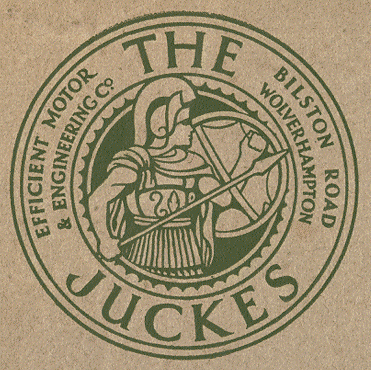 |
Around 1900, Mr. T. C. Juckes founded the Efficient Motor &
Engineering Company, based at East End Works, 315 Bilston Road,
Wolverhampton, close to where the Steelway factory now stands. Many types of
engines, including marine engines, general purpose industrial
engines, car engines, and motorcycle engines were manufactured
at the works. Other products included gearboxes, and lighting
sets.
The first Juckes motorcycle engines, and the first Juckes
motorcycles appeared in 1902. Ten years later the company
produced a 4hp. water-cooled motorcycle engine, and was one of
the first manufacturers of a 4-speed gearbox for motorcycles.
It is believed that Juckes built several motorcycles in 1907 using ACME V-twin
engines, Juckes 4-speed gearboxes, and a chain and belt drive. |
|
Four years later,
T. C. Juckes built 7 motorcycles using Bradbury engines, Juckes
4-speed gearboxes, and frames of his own design. 6 of the
machines were air-cooled, and one was water-cooled, with a small
radiator fitted to the downtube, and connected to special
water-cooled copper cylinder head.
|
| The location of the Efficient Motor &
Engineering Company. |
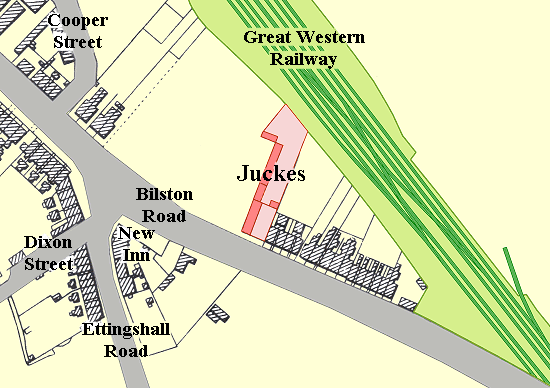 |
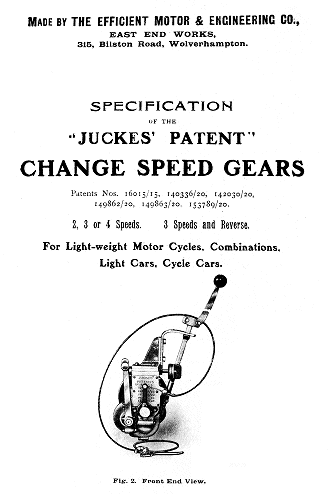 |
In 1913 and 1914 the Juckes 4-stroke, 4¼hp.
big single engines (with overhead or side valves) were used by
several leading motorcycle manufacturers.
Cycle cars and
motorcycles were built to order, and Juckes motorcycle engines
and gearboxes were fitted to many machines at the works. Special
parts were also made for the motorcycle assembling trade.
The company's main
product was the Juckes 3-speed countershaft gearbox and clutch,
which became known for its reliability.
The Juckes patent plate
clutch used a Ferodo disc plate to achieve a smooth, silky, and
positive action. During the First World War gearboxes were
supplied to four of the allied governments. |
| The range of gearboxes produced by the company in its later
years was as follows: For the
light-weight class.
Model L. 2 to3hp.
2-speed, plain type (no clutch or kick starter) with change
speed bracket, and lever.
Model J. 2 to
3hp. 2-speed, with clutch (handle bar controlled) and kick
starter, change speed bracket, and lever.
Model F. 2 to
3hp. 3-speed, with clutch (handle bar controlled) and kick
starter, change speed bracket, and lever.
Model 4F. 2 to
3hp. 4-speed, with clutch (handle bar controlled) and kick
starter, change speed bracket, and lever. |
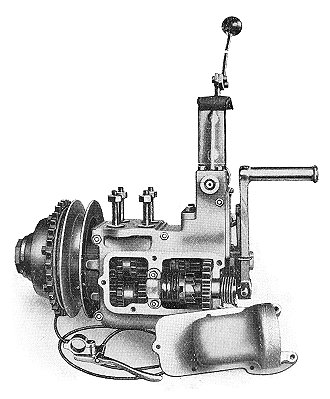
A Juckes gearbox. |
| For heavy-weights,
combinations, and cycle cars.
Model H. 3½
to 5hp. 3-speed, with clutch (handle bar controlled) and kick
starter, change speed bracket, and lever.
Model 4H.
3½ to 5hp. 4-speed, with
clutch (handle bar controlled) and kick starter, change speed
bracket, and lever.
Model 3HR. 3½
to 5hp. 3-speed and reverse, with clutch (handle bar controlled)
and kick starter, change speed bracket, and lever.
Model 8H. 5 to 8
/ 10hp. 3-speed, with clutch (handle bar controlled) and kick
starter, change speed bracket, and lever.
Model 48H. 5 to 8
/ 10hp. 4-speed, with clutch (handle bar controlled) and kick
starter, change speed bracket, and lever.
Model 8HR. 5 to 8
/ 10hp. 3-speed and reverse, with clutch (handle bar controlled)
and kick starter, change speed bracket, and lever. |
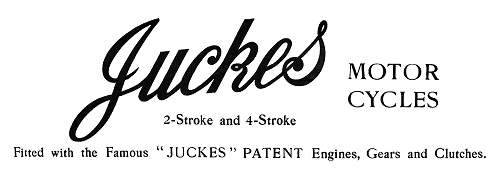
|
In the early 1920s T. C. Juckes decided to produce a range of
2-stroke motorcycles at the works, all built to his own design.
Many of the main components were also designed and built at the
works, including the engines, gearboxes, frames, petrol tanks
etc. The engines were of an improved 3-port design, which used
the Juckes patent double transfer passage and oiling system.
Through the passages the explosive mixture was conducted from
the ports to the centre of the crank case, directly into the
combustion chamber, where it arrived practically free from
lubricating oil vapour, which was trapped and retained in the
crank case where it belonged.
The first machines appeared in 1923. The models were as
follows:
The model 'A' was powered by a 2¾hp.,
2-stroke, 274c.c. engine, with belt drive; it had a top speed of
50 m.p.h., a fuel consumption of 100 - 160 m.p.g., and a selling
price of £34. The machine was designed so that the belt drive
could easily be replaced with a chain drive. Several other
versions were available:
The model 'A1' had a 2 speed gearbox and sold for £38.10s.
The model 'A2' had a 2 speed gearbox, clutch and kickstart, and sold for £45.
The model 'A3' had a 3 speed gearbox, clutch and kickstart, and sold for £46.10s.
The model 'A4' had a 4 speed gearbox, clutch and kickstart, and sold for £49.10s.
A 3h.p. engine could be fitted to any model for an extra £2.15s.
The model 'B' was powered by
the same 2¾hp., 2-stroke,
274c.c. engine, as in the model 'A' but came complete with a
chain drive, a 2 speed gearbox, clutch, and kick starter. It had
Swan forks, Hutchinson 26" tyres, and a Leckie pan seat saddle.
The petrol consumption was 100 - 160 m.p.g., and the machine
sold for £48.10s.
Two other versions were
available:
The model 'B3' had a 3 speed gearbox, clutch and kickstart, and sold for £51.10s.
The model 'B4' had a 4 speed gearbox, clutch and kickstart, and sold for £53.15s.
A 3h.p. engine could be fitted to any model for an extra £2.15s. |
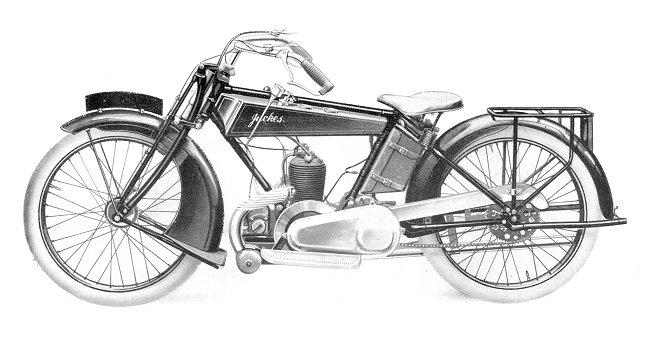
The model 'B'. From the 1925 catalogue.
| There was also a sports, or semi-sports machine, the model
'C', which had the same basic specification as the model 'B',
but with T.T. handlebars, smaller and lighter mudguards, a
straight-through exhaust pipe, foot rests, and special tuning.
|
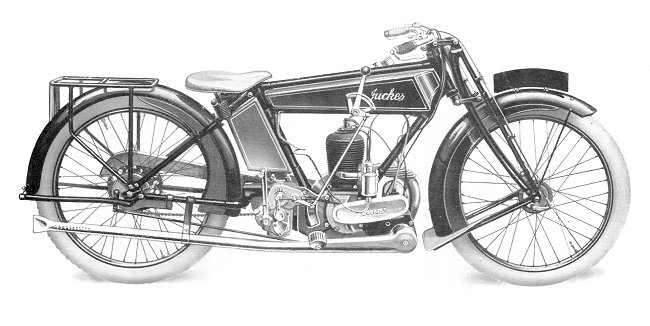
The model 'C'. From the 1925 catalogue.
| A sidecar could be fitted to any model 'A' or 'B' for an
extra £13.13s to £24, depending upon specification. Complete
model 'A' or 'B' combinations were available at a selling price
of £62.10s to £72.10s. depending upon specification. Juckes
combinations had a touring speed of 35 - 40 m.p.h., and a fuel
consumption of 60 - 90 m.p.g. |
|
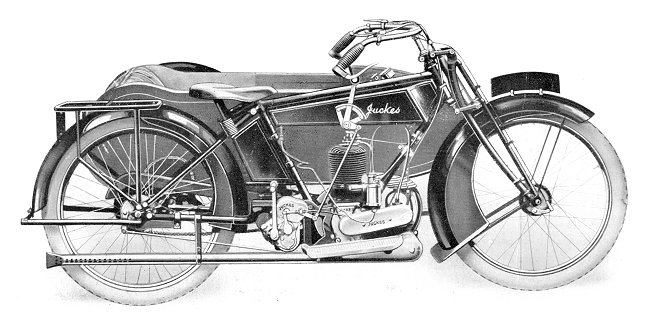
The Juckes combination. From the 1925 catalogue.
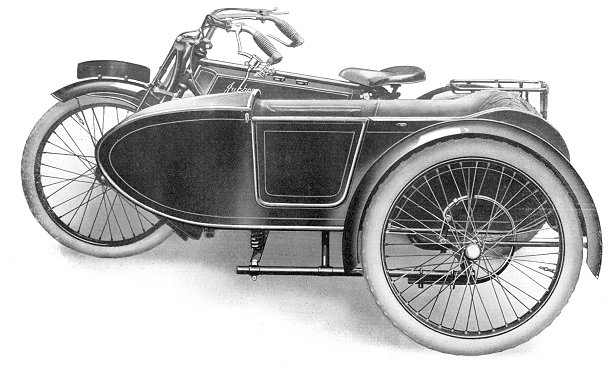
Another view of the Juckes combination. From the 1925
catalogue.
| In 1925 Juckes launched three high performance machines, the
'G', 'G4', and 'GA'. The machines were powered by a Juckes
4-stroke, 347c.c. O.H.V. engine, with a 3 or 4-speed gearbox,
mechanical and hand pump lubrication, kick starter, an extra
strong weldless frame, Druid forks, internal expanding front and
rear brakes, and touring, or racing handlebars. The machines
were finished in high quality black enamel, with the tank lined
in gold leaf. The differences in the models, were as follows:
The model 'G' had a 3-speed gearbox, whereas the model 'G4' had
a 4-speed gearbox. Both models had a top speed of 80 m.p.h., and
a petrol consumption of 80 - 120 m.p.g. A sidecar could be
fitted to either model for an extra £12.12s to £20 depending on
specification. The top speed with a sidecar and passenger was
55m.p.h.
The model 'GA', the special sports came as a racing or
touring model with a specially tuned engine. The frame was
fitted with duplex tubes at the front and rear, and with
stretchers, girders, and engine plates. The machine was
attractively priced at £54. |
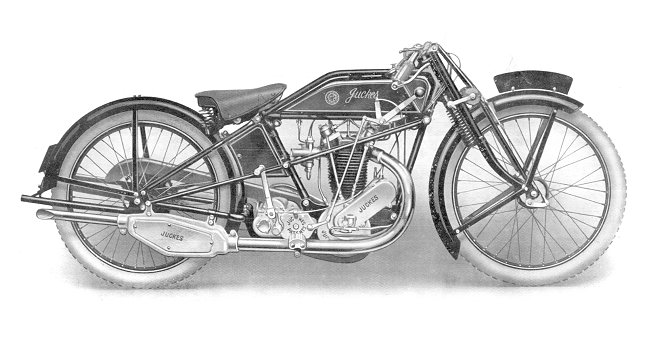
The model 'GA'. From the 1925 catalogue.
|
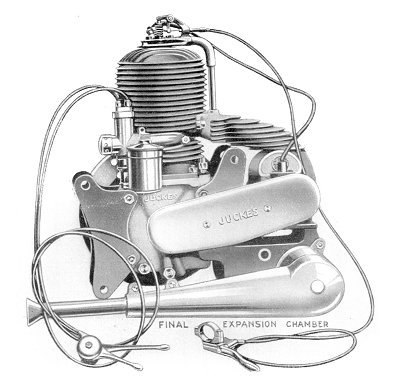
A Juckes motorcycle engine. From the 1925
catalogue. |
Unfortunately in the latter half of 1925 the company found
itself in deep financial difficulties, and was declared
bankrupt. At the time of closure only 9 'GA's had been built.
The two-stroke machines sold quite well, around 683 were built.
The company's best year was 1923, when over 400 machines were
produced.
The machines were not often seen in trials and competitions,
but in 1924 a Juckes machine won a silver medal in the Victory
Trial. |
| On Wednesday, 28th October, 1925 the buildings and plant
were auctioned at the Victoria Hotel, Wolverhampton.
They were all purchased by Mr. Swaite, a director of Grays
Engineering. On the following Monday the patent rights, loose working
plant and tools, office furniture, and the stock of finished and
part-finished motorcycles, and components were auctioned at the
Victoria Hotel by John Layton of Darlington Street,
Wolverhampton. They were purchased by Richards of Wallington
Crane Hire. The motorcycle parts were eventually donated to the
National Motorcycle Museum. |
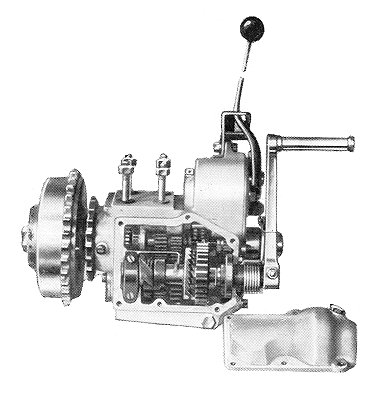
A Juckes motorcycle gearbox. From the 1925
catalogue. |
The production figures were listed by T. C. Juckes in a
ledger, as follows:
Motorcycles:
|
Year |
Quantity |
| 1911
to 1912 |
9 |
| 1913
to 1918 |
18 military machines for the army |
| 1922 |
1 prototype |
| 1923 |
407 |
| 1924 |
224 |
| 1925 |
60 (51 two-stroke, 9 O.H.V.) |
| |
|
| Total |
719 |
In between 1902 and 1925 a total of 4,703 gearboxes were
produced, along with 90 non-motorcycle engines. It is also
thought that two 601c.c. motorcycles with a bore of 87.5mm, and
a stroke of 100mm were produced. The first in 1902, and the
second in 1910.
The Efficient Motor and Engineering Company went into
liquidation in 1925, and East End Works and the fixed plant and
machinery were auctioned on 28th October, 1925 at the Victoria
Hotel. The loose plant and the office furniture were auctioned
on 2nd November.
The sale details include a description of the factory, which
was quite small, considering the products that were produced.
The main building consisted of a machine shop and stores,
measuring 95 feet by 45 feet, a drawing office, a clerk's
office, and a main office. It was built of brick, with a glazed
span-roof, and brick paved floor. In the yard were other
buildings, consisting of a brick and wood built workshop and
store, 61 feet long by 17 feet wide, a brick built two storey
store, an open wood and iron shed, and a toilet block with six
toilets.
After the closure, Mr. T. C. Juckes ran a
motor repair business at 31 Cleveland Street, Wolverhampton,
trading as "T. C. Juckes Motor Repairer". The business survived
until 1962. |
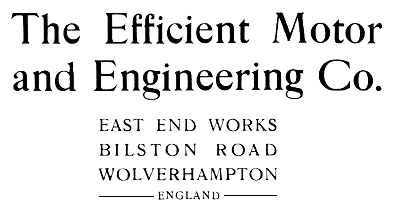
Some of the information used in this section was kindly
supplied by Ray Jones, in the form of a letter that was written many years
ago by the Juckes Marque Specialist, John Reed.
|